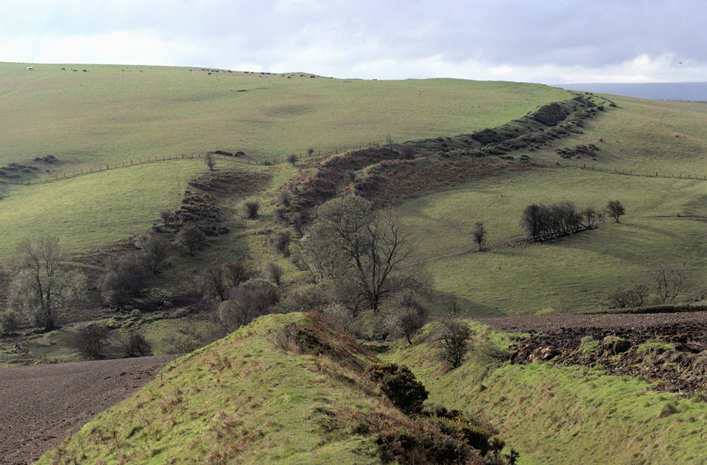Offa: Mercia's Shining Light
Offa was one of the most charismatic and successful of the early Anglo-Saxon kings. He was a visionary who saw the need for a strong defense and a strong economy in his Kingdom of Mercia and in England overall. Among his more far-reaching programs were the establishment of market towns, the issuing of gold coins, and the construction of Offa's Dyke, a huge man-made earthen structure that effectively approximated the border between Mercia and Wales.
By this time, the kingdoms of Kent and Sussex were in decline and so Offa and his Mercians assumed control of those kingdoms as well. An alliance with Beorhtric of Wessex, courtesy of that king's marrying Offa's daughter Eadburh, put Offa in a great position to extend his sway over all of southern England. He did just that by adding East Anglia to his retinue. Because of all of this power, Offa is thought by many historians to have been bretwalda, even if his name doesn't appear in lists of the overlords. While he ruled, Offa was the most powerful leader in England. Near the end of this reign, he added Northumbria to his haul by marrying another daughter, Ælfflaed, to Northumbria's king, Æthelred I, and cementing an alliance between the two lands. Letters from near the end of Offa's reign suggest that the Mercian king and the famous Frankish ruler Charlemagne treated each other as equals. Offa is also known to have had diplomatic relations with other European leaders as well.
Offa directed the printing of Mercian coins and established a mint at London. Some coins have his face on them; others have an image of his wife, Cynethryth (the only Anglo-Saxon queen ever depicted on a coin); other coins have the words "Offa Rex."
Many historians think that Offa's Dyke was built not only as a demonstration of Offa's power and prestige but also as a means of defensive positioning. A walk on top of the length of the Dyke offers an uninterrupted view from Mercia into Wales. Those who built the Dyke ensured that any hills or high ground were to the east of the Dyke, in Mercia; also in Mercia was the soil that came from the ditch dug on the Welsh side. Offa was one of early England's most famous names, and he ruled for a few decades, dying in 796. His son Ecgfrith didn't have the power that his father did, nor did his brother, and Mercia struggled on for its independence until being eclipsed by first Wessex and then Viking kingdoms. |
|



 An 8th-Century leader named Æthelbald ruled Mercia for more than 40 years and faced down challenges from powerful kings in Kent and Wessex. For a time, Æthelbald was the effective ruler of all kingdoms south of the Humber River (leaving out only Northumbria). A bodyguard killed Æthelbald, and civil war ensued. The winner of that internal struggle was Offa, who assumed the throne of Mercia in 757.
An 8th-Century leader named Æthelbald ruled Mercia for more than 40 years and faced down challenges from powerful kings in Kent and Wessex. For a time, Æthelbald was the effective ruler of all kingdoms south of the Humber River (leaving out only Northumbria). A bodyguard killed Æthelbald, and civil war ensued. The winner of that internal struggle was Offa, who assumed the throne of Mercia in 757. Offa encouraged the establishments of market towns, some of which are said to have survived as Northampton, Oxford, and Stamford. The towns, which functioned primarily as administrative centers for trade, were also defensive in nature, predating the famous burhs pioneered by Alfred the Great.
Offa encouraged the establishments of market towns, some of which are said to have survived as Northampton, Oxford, and Stamford. The towns, which functioned primarily as administrative centers for trade, were also defensive in nature, predating the famous burhs pioneered by Alfred the Great. The most recognizable legacy of Offa is something that still exists, to a large extent: Offa's Dyke. It is a massive earthen barrier that effectively formed the barrier between England and Wales, specifically between the English Kingdom of Mercia and the Welsh Kingdom of Powys. The Dyke was up to 8 feet high and up to 65 feet wide and took 12 years to build. A modern footpath that roughly parallels the Dyke runs 177 miles.
The most recognizable legacy of Offa is something that still exists, to a large extent: Offa's Dyke. It is a massive earthen barrier that effectively formed the barrier between England and Wales, specifically between the English Kingdom of Mercia and the Welsh Kingdom of Powys. The Dyke was up to 8 feet high and up to 65 feet wide and took 12 years to build. A modern footpath that roughly parallels the Dyke runs 177 miles.
